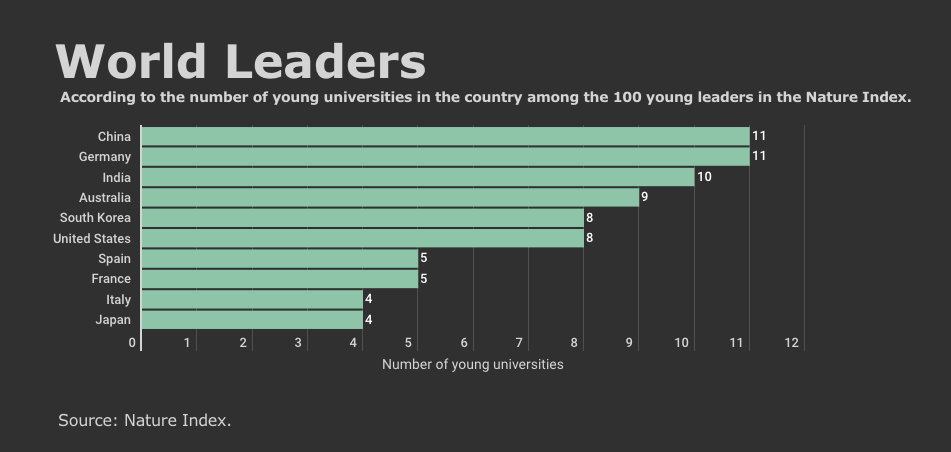The scientific journal Nature has released the Nature Index ranking that recognizes the most outstanding universities under fifty years old in the creation of scientific research. This classification formed part of the first special report, Young Universities 2019, reporting on emerging universities, underscoring their production of research articles, and also exploring the strategies behind the success of these institutions despite their youth.
This year, the universities with the highest scores in the production of scientific material were distinguished in various areas under the metrics of Article Count (AC) and Fractional Count (FC), whose functions are to measure the number of articles and the contribution that a university makes to any of these areas.
This year’s results revealed that young universities in China, South Korea, Germany and India played outstanding roles on the leaderboards. This is no surprise, as in 2018, China took the lead by taking nine of the top ten places awarded to leading institutions under the age of 50. Without lowering its position a year later, the Asian country found itself on par with Germany within the 100 best universities in the Nature Index, with 11 institutions featured in the ranking of young universities.
David Swinbanks, the founder of the Nature Index, says, “It’s interesting to note that many of the most successful young universities have similar traits. In addition to being free from the traditions that often characterize older institutions, these younger universities often have strong interdisciplinary cultures and pride themselves on promoting creative thinking as well as providing leadership opportunities to young and mid-career researchers. These measures also help attract a diverse student population and encourage the search for unconventional research that inspires innovation.”
Top 9 Young Universities
These are the nine emerging universities that have shown a promising role in creating scientific research:
-
Federal Polytechnic School of Lausanne (Switzerland)
Located in the heart of Europe, the Federal Polytechnic School of Lausanne (EPFL) is home to one of the year’s most promising innovative research studies, taking the top spot on this list and occupying second place in the classification of Young Universities by the Times Higher Education, launched this year.The study, published in Nature and Nature Neuroscience, is led by Grégoire Courtine, a neuroscientist at the Brain Mind Institute at EPFL, and Jocelyne Bloch, a hospital neurosurgeon there. The study tracks a wireless device placed in the spine of volunteer patients with paralysis, which produces alert signals in the muscle groups of the legs to mimic those that are emitted by the brain.
-
ShanghaiTech University (China)
Named the fourth fastest-growing university among other young institutions, ShanghaiTech University has become one of the largest producers of high-quality scientific content in its country. Zhong Chao, a nanomaterials scientist, mentions that one of the reasons for the increase in its growth is because the educational system there does not impose on new scientists by pressuring them to join a team of professional researchers just recruited. Instead, they are given the freedom to explore the branches of research that interest them most. Thus, new scientists independently can take more risks in their research, boosting their innovation. -
Ulsan National Institute of Science and Technology (South Korea)
This institute is one of the four public universities in South Korea that are dedicated to research in science and technology, but it stands out by being ranked number 10 in the ranking of young universities. “UNIST has become one of the most prominent institutions studying sustainable technology in Korea,” says Sang-Il Seok, a scientist whose team of researchers specializes in solar cells using a perovskite compound, making it easier to manufacture the cells compared to using other materials such as silicone. -
Shenzhen University (China)
Shenzhen University (SZU), a higher education institution located in China, is considered by the Nature Index to be the third fastest-growing university in the areas of chemistry and physical sciences, in addition to having partnerships with more than 256 universities for the development of collaborative research and educational training.Among its prodigious students are personages such as Ma Huateng, founder of Tencent, the leading social network in China, Shi Yuzhu, creator of the online video game company, Giant Interactive Group, and student Tu Hongyan, president of the line of Wensli clothing created from silk.
The university also has one of the most cited scientists in its faculty, Zhang Han, professor of optics and photonics, who recently conducted a study in graphene for the creation of photonic laser devices and their diverse uses in areas such as medicine, communications, and quantum science.
-
Daegu Gyeongbuk Institute of Science and Technology (South Korea)
Located in the city of Daegu, South Korea, this university specializing in science, engineering, and technology has an FC of 19.99 and an AC of 53, collaborating and actively participating in the creation of scientific research. Such is the case that Hongsoo Choi and his team of neuroscientists at the university reported in May 2019 the creation of micro-robots capable of supplying stem cells within the body of a living mouse. This signaled the potential future of the development of a system capable of restoring brain functionality through the transport of specific cells. -
Oregon Health and Science University (USA)
This public university in Oregon, which has a main campus and two hospitals in Portland, is the home institute for the development of treatments aimed at acute myeloid leukemia (AML). In addition, it ranks number 11 among the other universities in the ranking by the Nature Index.Over the past 40 years, research around the disease has suffered from a slowing in progress for new alternatives. However, since 2016, under the guidance of the university’s director, Brian Druker, the Beat AML program has been established that seeks to discover specific treatments aimed at this condition. “Working in a relatively young institution has allowed me to move quickly and get things done without having to navigate layers of bureaucracy.” In addition to “being willing to embrace ideas that might be considered outside the mainstream has allowed us to develop new and paradigm-changing research,” Druker says.
-
Queensland University of Technology (Australia)
With two campuses located in Brisbane, Queensland, and a science and research center, Queensland University of Technology (QUT), established just 30 years ago in Australia, is one of the six most promising emerging universities in the world, according to the Nature Index. This is how Christopher Barner-Kowollik, a researcher at the university, makes a brilliant contribution by developing a synthetic material that manages to change its structure under different light conditions. -
University of Paris-South (France)
With an FC of 71.08 and an AC of 574, this French university located in the south of Paris finds itself within the standings. One of its most outstanding contributions comes from the participation of Francois Costard, a geomorphologist at the university and Director of Research at the National Center for Scientific Research (CNRS). His work is part of that directed towards the historical evidence of oceans on the surface of Mars. This study provides samples of liquid water that may have remained on this planet for millions of years due to a massive shock wave of an asteroid. -
Hong Kong University of Science and Technology
Despite being a relatively small university (it has 11,205 students and a faculty of 680 professors), the Hong Kong University of Science and Technology offers an FC of 108.39 and an AC of 310, making it the fifth-highest-ranked-young university according to the Nature Index, and ranked 32nd in the 2020 QS
World University Rankings published by Quacquarelli Symonds.This university, at just 28 years old, has become a reference point for the various rankings among institutions of its class. In addition to its traditional areas of strength such as computer science, quantum physics, and medical sciences, it surprisingly has also made particular progress in research projects about proteins that promote the development of neurons that combat degenerative diseases such as Alzheimer’s.
For more information about these rankings, visit the Special Report Young Universities 2019, published by Nature.
This article from Observatory of the Institute for the Future of Education may be shared under the terms of the license CC BY-NC-SA 4.0 
)
)


)